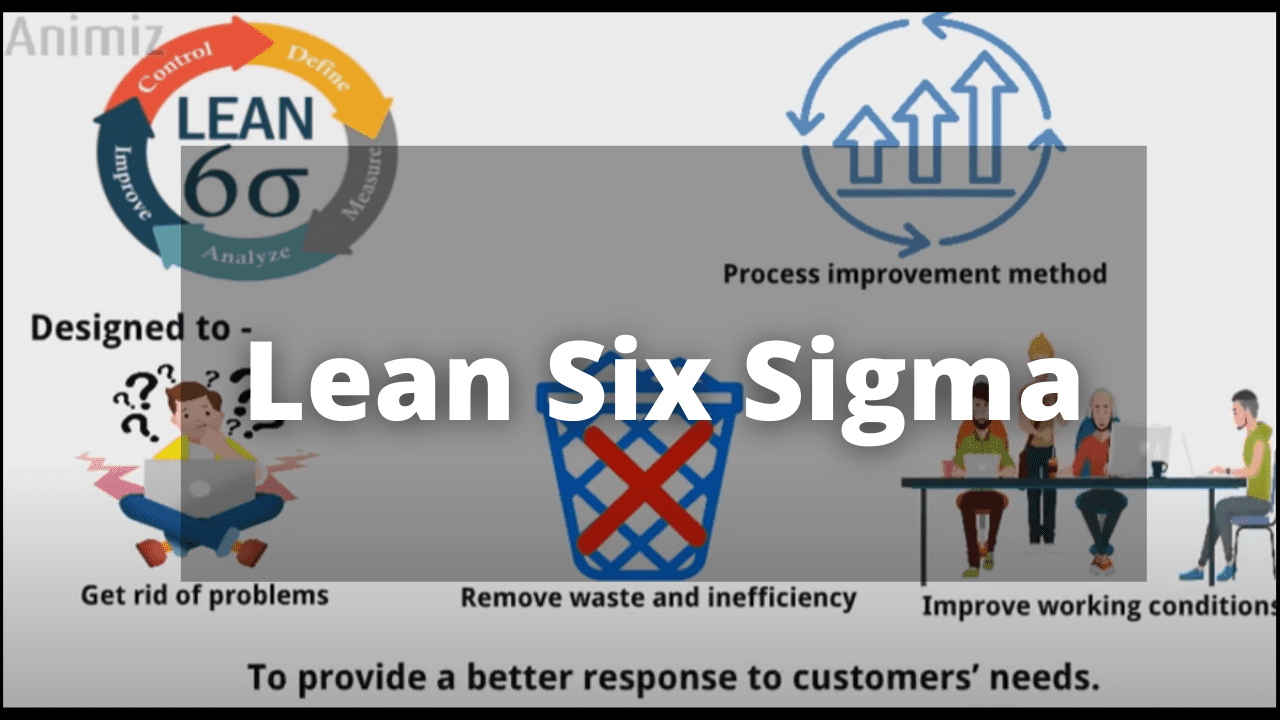Lean Six Sigma is a business ideology focusing on breakthrough improvement and merged Lean philosophies with the Six Sigma method. Lean Six Sigma concentrates on improving productivity and reducing inconsistency in every business process. In a service environment, a Lean Six Sigma process would be very much predictable and virtually error-free.
This means that out of one million products manufactured or services provided, a process operating at a Six Sigma level would cause only 3.4 errors with minimum time and other resources to process these orders. This level of performance is a great improvement over where most organizations currently perform at a three sigma level, which results in over 66,000 defects/errors per million opportunities and where 80%-90% of the process does not add importance to the product/service from the customer’s viewpoint.
The team-oriented approach of lean six sigma has proven results in maximizing efficiency and also improving profitability for businesses around the world.
What you are going to learn?
Definition Of Lean Six Sigma
Lean Six Sigma is a process improvement method planned to eliminate problems, remove waste and errors, and enhance working conditions to provide a better response to customers’ needs.
Or
Lean Six Sigma is a fact-oriented, data-driven philosophy of improvement that values error prevention over error detection. It drives customer satisfaction and bottom-line results by shortening variation, waste, and cycle period, while promoting the use of work standardization and flow, creating a competitive advantage.
Or
Lean Six Sigma is an approach that relies on a collaborative team effort to increase performance by systematically eliminating waste and reducing variation.
Key Elements to Lean Six Sigma
There are basically three elements of lean six sigma. These three elements support one another. Analytical techniques are not used productively unless there is a process for applying them and a mentality of regular improvement, creating the need for them. An improvement process does not provide the desired results unless it receives the tools and techniques that define the activity of the process steps and there is a culture that insists on a fundamental data-based technique for solving problems.
These techniques are;
Tools and Techniques:
A complete set of tools and analytical techniques are used to analyze and solve problems.
Process and method:
A sequence of phases that organize the use of the problem-solving tools to assure that the true root causes are found and that a solution is fully accomplished.
Mindset and Culture:
A manner of thinking that is based on data and processes to gain operational performance goals and constant improvement.
Before deep more into the topic, first, we should know what lean is;
What is ‘Lean’?
When a company is producing/providing services on a very large scale, it means that the company is creating a high quantity of waste. Any company prefers not to do this. Therefore, the lean approach uses tools to determine and deal with the business process.
The principal driver of Lean is the elimination of waste. In fact, an appropriate description of the Lean approach is a set of tools that benefit in the identification and the continuous elimination of waste.
Lean was first developed in Toyota as a part of the Toyota Production System around the work of Shewhart and Deming.
Principles of Lean Manufacturing
There are mainly 5 principles of lean manufacturing;
1. Value
Value is determined by the perspective of the customer and relates to how much they will pay for your products or services. The company or service provider who should seek to eliminate waste then found this value and costs to meet the reasonable price for the customer while also maximizing profits.
2. Value Stream
Map the Value Stream requires analyzing the materials and other resources needed to produce a product or service to classify waste and improvements. Value stream mapping involves the product’s entire life-cycle, from raw materials through to removal. Every stage of the production cycle needs to be checked out for waste and must exclude almost everything that does not add value.
3. Flow
Eliminate possible barriers and identify the ways to improve lead time. This principle assures that processes are flowing smoothly and can be undertaken with minimum delay or other waste. Lean manufacturing is based on ignoring interruptions in the production process and setting up a unified and integrated set of processes in which activities operate in a constant stream.
4. Pull
The degree to which the value stream is only processing products and services for which there is a customer requirement, rather than producing something and hoping someone needs it.
5. Perfection
The Lean Manufacturing Technique seeks perfection, minimizing errors and waste. As products are made, the accomplishment of perfection continues, making for continuous improvements along every step of the process.
Wastes of Lean Manufacturing
Overproduction: Instead of manufacturing just in time, manufacturing an item before it is required is considered overproduction.
Waiting:
Often a product’s lead time is tied up in waiting for the next process; this is mostly because the flow of material is poor, production runs are too long, and distances between work-stations are too long.
Transport:
Excessive operation and handling add costs and time to material handling processes. Decreasing transport time to carry any item from one place to another leads to the Lean process.
Over Processing:
Wasting time on a product feature that does not affect functionality leads to over-processing. Over-processing can also be associated with using more expensive equipment when simpler machinery can do the same thing.
Excess Inventory:
Takes up space and eats into working capital. A smooth flow between work centers helps to shorten inventory and work in process.
Excess Motion:
Reducing bending, reaching, lifting, and walking can reduce worthless motion.
Defects:
Quality errors occur in rework or scrap, including costs to the manufacturing process.
To read more about Lean Manufacturing, click here>>>
What is Six Sigma?
Six Sigma is better than training; it is an approach based on data and adjusted toward projects with significant business results. This proven method has been implemented within a wide range of industries to accomplish both hard and soft money savings while improving customer satisfaction. For example, in 1999, GE Capital could save $2 Billion with Six Sigma.
Six Sigma was first introduced at Motorola during the late 1980s. The method was discovered by Bill Smith, a quality engineer, whose goal was to improve the way the quality and measurement systems worked to eliminate defects. The Motorola systems tolerated error rates that produced too much junk, revise, unnecessary testing, and often customer dissatisfaction.
Definition of Six Sigma
Six Sigma is a method used to enhance business processes by applying statistical analysis rather than just guessing. Processes are enhanced by controlling change and figuring out the complexities within them. This results in more certain and effective business processes.
Phrases of six Sigma
1. Define:
In this process, process boundaries being analyzed are set the expectations for that process are defined from a customer perspective.
2. Measure:
In this stage, the current performance of the process, product, or service is analyzed to figure out what is actually happening, especially from a customer perspective.
3. Analyze:
In this stage, the process, product, or service is evaluated using the measured data to figure out the source or sources of the variation that is leading to the problem.
4. Improve:
In this stage, the variations, products, or services are evaluated and a solution set of changes is created and tested.
5. Control:
In this stage, the changes are applied, the supporting structures are also updated and the process, product, or service is brought under control.
To read Six Sigma in detail, click here>>>
Similarities and Differences of Lean and Six Sigma
Although lean and six sigma are unique, they are complementary to each other. Therefore, they are combined.
Here I’m discussing some similarities and dissimilarities of lean and six sigma.
Similarities:
- Both believe in a definition of value that is completely based on the customer experience.
- Both apply a process flow mapping technique to understand the process
- Lean and six sigma both rely on data for determining current performance and for measuring the impact of future performance.
- Both are implemented using improvement projects that typically will be completed by a small cross-functional team.
- They both have migrated beyond the manufacturing process and are now used for all functions and for all internally facing and externally facing processes.
- Improvements based upon using either technique will normally both cut down waste and reduce changes.
Dissimilarities:
- Different focus for problem identification–Lean is concentrated on waste and Six Sigma is concentrated on variation.
- Different techniques–Lean primarily uses visual approaches for both analysis and solution formation that are supported by data analysis. Six Sigma primarily applies statistical approaches for analysis and solution creation that are supported by data visualization.
- Different documentation for the solution–the Lean solution is documented with a revised value stream map that changes in workflows and often changes in work instructions at many steps of the process. While,the Six Sigma solution is documented with changes in setup operations and the control plan for observing the process and responding to variation.
Principles of Lean Six Sigma
Now let’s discuss some principles that make lean six sigma so effective.
Customer Attention:
For any business, the customer is the major factor. Every product should be designed regarding customer requirements, as a satisfied customer is said to enhance the business service/product quality.
It’s a well-known fact that no business would exist without customers; therefore, it is essential to cater to the customer’s requirements before applying any changes. Each step of the company should focus on giving maximum value to the customer.
Value Stream Mapping:
Value Stream Mapping is basically a flowchart representing the steps associated with the production/service process. This provides a clear view of the complete process from start to end and reduces, focusing on a single step. It illustrates how the business visualizes all the steps and highlights the waste area. When the value stream mapping is ready, you will find the root cause of the issue.
Removal of Waste and Reducing Variation:
It is necessary to remove the waste and reduce changes before making any improvements to the existing process. After analyzing the root cause of the waste/variation, the next step is to remove or eliminate it, as it doesn’t add any worth to the ultimate product. Steps involved in waste reduction:
- Visible the waste
- Be alert
- Be responsible
- Measure and eliminate.
Steps involved in variation/change reduction:
- Process Documentation
- apply the best practices
- Create and share a checklist with your team
- Make sure that everyone gets the training
- Incorporate forms
- Modify anything that is error prone.
Flexible and Adaptive:
The entire idea behind applying Lean Six-Sigma is to accept the change. Having good communication concerning the change in the process motivates the team to adopt it.
Team Communication
The team members and management should acquire a thorough knowledge of Lean Six-Sigma Processes. While implementing any team changes, it’s necessary to have clear communication concerning a new set of practices and standards. There should be proper training sessions for every employee and get feedback from them.
Benefits of Lean Six Sigma
Lean Six Sigma is a steady improvement method. Now let’s look at benefits for the organization and then benefits for the people who earn a level of certification in Lean Six Sigma.
Simple Process:
Lean Six Sigma simplifies the business processes. The cross-functional value stream maps will find out the areas of waste and inefficiency. Many processes have embedded rework and workarounds for endless problems. When the wasted effort is withdrawn and the rework and workarounds are no longer required, the remaining processes are simple and often much simpler to manage and control.
Fewer Errors:
Lean Six Sigma appears with a definition of sufficient quality based upon what the customers demand. This external focus on quality prioritizes the continuous improvement attempts to discuss the problems that have the most impact on business success.
The dependence on data to define problems rather than gut feel or anecdotes further prioritizes the improvement effort on the actual problems in the organization.
Predictable Performance:
Simple processes are easier to control than complex processes, specifically those processes with fewer faults, errors, and mistakes.
Lean Six Sigma has a focus on shortening variation within a process. With fewer variations, processes become more clear and predictable. It means a predictable cycle period, predictable quality production, and predictable costs. And these can benefit better customer service, fewer objections, and greater profits.
Active Control:
The Lean Six Sigma method reduces cycle times and puts in place real-time data-based control strategies and systems. With shortened cycle times and data-based control systems, the operators and process managers can make decisions that directly affect process performance. This improves performance, improves employee attitude, and increases agility.
Personal Effectiveness:
Lean Six Sigma provides an organized problem-solving method that can address any type of problem. Being prepared to find and fix problems will increase your capability to perform in any position and industry.
Leadership Opportunity:
Leading a Lean Six Sigma project will give a chance for exposure to other functions and senior management. This exposure is for someone who can find and fix an issue. Collaborating with team members and managers will probably improve your communication and decision-making skills.
Lean six sigma structure helps you develop your project management skills and of course that will create an opportunity for your promotion.
Lean Six Sigma Belts
Lean six sigma belts define the levels of lean six sigma certifications. And these certifications determine the roles that individuals are qualified to play in accomplishing projects and promoting quality management practices.
There are 5 types of LSS belts;
White Belt:

Professionals are considered Six Sigma White Belts if they have not experienced a formal certification program or advanced training. A single session with an analysis of relevant techniques and vocabulary for lean six sigma shows workers at all levels of an organization how they contribute to productive, reliable outcomes. With this basic grounding, White Belts take part in projects and problem-solving tasks associated with quality management and waste reduction.
Yellow Belt:

A Yellow Belt designation shows exposure to Six Sigma approaches that go beyond the fundamentals provided for a White Belt. Yellow Belts may have attended training sessions over a day or two, acquiring the knowledge they need to be appointed to a project as fully assisting team members. They may handle limited-scope projects and support managers at higher belt levels.
Green Belt:

Achieving a Lean Six Sigma Green Belt certification requires professionals to attend a full course that introduces them to Six Sigma approaches for developing and improving products, services, and operations.
Green Belt training is valuable for individuals in positions like project manager, health care administrator, or financial manager, giving them a knowledge of performance metrics and tools like control charts and Failure Modes and Effects Analysis.
Black belt:

After achieving their Green Belt certifications, leaders may take their skills to next level by achieving Six Sigma Black Belt certification. This advanced training requires past knowledge of lean six sigma strategies as professionals master the skills they desire to plan, lead and analyze more complex and expansive projects or organizational changes.
During a Black Belt-level course, professionals show what they’ve learned and gain hands-on experience by attending a project for their company or a nonprofit organization.
Holders of a Lean Six Sigma Black Belt execute lean six sigma projects, monitor outcomes, and manage team changes. They run quality improvement and Lean efforts hoping to make a significant impact on company-wide productivity.
Master Black Belt:
A seasoned Black Belt with effective leadership and problem-solving skills can become a Master Black Belt in lean six sigma. This designation shows that a professional takes a complete view of strategy throughout a business, coordinating teams across.

